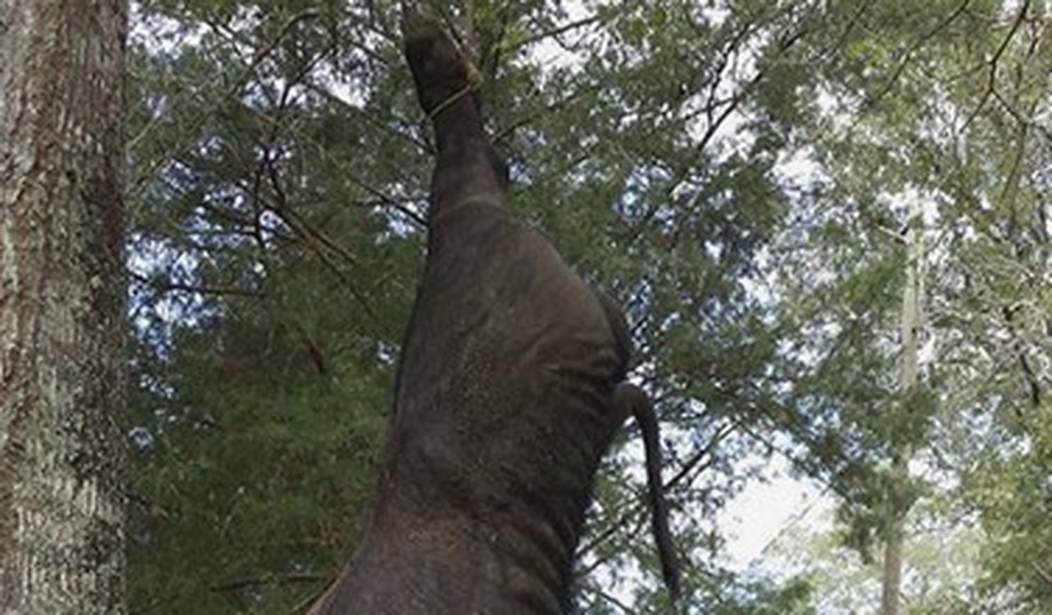Spring is in the air. Baby birds will soon be chirping in nests lovingly constructed by their attentive parents...unless they're cowbird chicks, who get abandoned in a neighboring nest. But let's not dwell on such unpleasantness.
Lambs will be gamboling about pastures, and wee colts will be standing on wobbly legs for the first time, perhaps the next Secretariat in the offing once those gams get steady and strong.
It's also time to yoink your chains and maybe talk about feral hogs again - as we did last fall - since their numbers will begin to increase after the winter hiatus.
In that post, we talked about pigs from California to Florida, devastating agriculture, woodlands, wetlands, and - frighteningly enough - even landscaping in front yards in the middle of developments.
But the out-of-control feral population isn't confined to the southern tier and western states. Manitoba, Canada has huge problems with wild hogs and is trying to enlist the public in their eradication efforts.
...The Squeal on Pigs campaign was launched in Manitoba in 2022 to inform the public about the damage caused by wild pigs and what to watch for and to provide a mechanism to report sightings. Squeal on Pigs Manitoba Coordinator Dr. Wayne Lees told those on hand last week for Manitoba Pork’s 2024 annual general meeting the risks posed by wild pigs fall into three categories.Quote-Dr. Wayne Lees-Squeal on Pigs Manitoba:
They affect animal health and those risks are mainly due to their ability to transmit diseases. There’s an environmental risk and then finally there’s a human safety risk because these animals can be quite aggressive and if they are cornered they can pose a risk to human safety.Probably the most well know populations of wild pigs are in the southern U.S. In those southern states wild pigs are really out of control and their populations are estimated to be in the millions and they cause a lot of damage down there. Our situation in Canada is a bit different. The Eurasian wild boar, that were brought into this country in the 1980s and 1990s have escaped or were released and now have established breeding populations, usually in the agricultural or the semi agricultural areas of the province.
Our pigs tend to survive the winter much better. These wild pigs in Canada are adapted to cold climate conditions and so our strategies have to be different. They tend to travel in smaller groups in this country, they tend to travel around more and they tend to be more elusive, they’re harder to find than pigs in the U.S.
There's no love lost for feral hogs from Canada to Florida. Particularly with the rise of "super pigs." Who needs that?
...For Ryan Brook, professor at the University of Saskatchewan's department of animal and poultry science, "wild pigs are the worst invasive large mammal on the planet from a Canadian perspective". He and others cite the "tremendous" damage their rooting, wallowing and trampling has done to agricultural crops; as well as the threats they pose to livestock, endangered wildlife, disease transmission and water quality.
Brook's team have thus mapped the hogs' advance across Canada, and even identified what they call a "super pig" – a fast-breeding hybrid that is well-adjusted to cold climates. A group started by researchers, called "Squeal on Pigs", is now on the lookout for their spread across the border.
Inside the US, there is already a national programme working to see existing wild pig numbers controlled or, "where feasible", eradicated. Considering their conservation threats and the economic damage their spread has led to, this approach receives widespread support.
"Economically and ecologically, the hog invasion has had an overwhelmingly negative effect," says Marc Hensel, a coastal ecologist at the University of Florida's Nature Coast Biological Station.
In Connecticut, irresponsible farmers are looking at the possibility of foreclosure thanks to fears of repeated groups of pigs - up to 22 at a pop - escaping from their farm, and rambling about the countryside, damaging property as they go. There are reports that the pregnant escapees have given birth while loose and fears that they'll form a feral population in the suburban woods.
A state legislator from the area in eastern Connecticut where roaming pigs and cattle have damaged crops, fields, and lawns said civil action that could lead to property foreclosure is a better remedy than the current pile of infractions that seem to be stalled in criminal court.
...Cows from the Radical Roots Farm have been loose in Sterling recently, trampling a garlic patch and eating some of a farmer's silage, town Zoning Enforcement Officer Victoria Robinson-Lewis said. Pigs from the farm have not been seen in the kinds of numbers — as many as 22 in one group — as last fall, Robinson-Lewis said, but they have been sighted in local woods, and the sows are bearing litters in the woods. First Selectman Link Cooper said he expects a return in force of ravaging swine and cattle as the weather warms.
...A major concern of local officials and state lawmakers is that the loose hogs could go completely wild and start wreaking widespread damage as feral swine have done in other parts of the U.S.
There is no doubt they are fertile buggers.
...Feral hogs can breed year-round and have up to two litters of four to 12 piglets each year. The animals are sexually mature at 6 to 8 months of age, so populations can double in size in four months, according to the USDA.
Wild pigs can breed several times a year, eat anything, and go just about anywhere — and cause problems. https://t.co/O5il8IR18B
— Popular Science (@PopSci) April 15, 2024
They are also extremely tough. Tough enough to survive Manitoba winters, and many are damn near tough enough to survive anything thrown - or shot - at them.
One bullet for one boar makes for poor hunting odds. In 1984, on the trail of a tracking receiver in the woods of South Carolina, Jack Mayer caught sight of radio-collared wild pig #20, drew a bead and squeezed the trigger, slamming a 12-gauge rifled slug into the body of a 200-lb. survival machine. The lead ripped through the wild pig’s shoulder, bounced up across the neck, and deflected into the lower mandible, severing the jawbone in half.
The pig wheeled around, charged one of Mayer’s fellow researchers up a tree, and dashed into deep cover and the relative safety of a lost radio signal. A year later, checking a wild turkey food plot at sunset, Mayer walked up on a large boar gorging on feed corn. He quietly slipped in and fired, dropping the boar in the middle of the plot. A Lazarus beast beneath his feet, Mayer had finally killed #20.
The subsequent necropsy revealed the trajectory of Mayer’s initial 1984 slug. Incredibly, #20 had entirely healed and gained weight after the shooting. Any other animal with a gaping wound, mangled body tissue and broken jaw would have starved to death, yet #20 had survived and thrived.
Which would be laudable if they weren't so God awful dangerous to have around.
“The wild hog is very possibly the most dangerous animal in the wild. And he knows no enemies and he knows no fear,” says Hank Berdine of the Mississippi Levee Board in a new video series, Feral Swine in America.
Listen to true stories from farmers and ranchers in a gut-wrenching new video series from USDA that chronicles the impact of feral swine damage on American livelihoods and ecosystems. Through personal accounts from farmers, ranchers, land managers, conservationists, and others who deal with feral swine damage, this series aims to show the heartache caused by one of the country’s most invasive enemies.
It has gotten to the point in many communities that the pigs rule the neighborhoods at night. As I related in my earlier post about my Daddy's little community on the outskirts of Cleburne, TX, walking the dog after dark became an article of faith with the danger of feral hogs always in the taller grass and scrub brush at the edge of the yards.
Research for a study (released in late 2023) by a team led by John J. Mayer, technical program manager at the Savannah River National Laboratory, had an eye-opening statistic in it.
Wild pigs kill more people worldwide than sharks do.
...Between 2014 and 2023, the average yearly number of fatal shark attacks worldwide was 5.8, while the average number of fatal wild pig attacks was 19.7. In 2024 alone, there have already been seven deaths from wild pig incidents.
According to groundbreaking research published in 2023, the number of humans killed by wild pig attacks steadily climbed from 2000 to 2019, for a total of 172 deaths—including a freakishly grisly fatality in southeast Texas.
In most cases, these poor folks weren't hunting. They were agriculture types or, worse - simply stepped out of a vehicle at the wrong time.
...Of the 172 fatalities, 88% occurred in non-hunting circumstances; 77% of victims died due to blood loss; 86% of attacks occurred in daylight; 84% of victims were male and 62% of victims were adults; 38% of attacks involved farm workers engaged in agriculture; almost all attacks were by solitary pigs, except for 20 encounters featuring multiple pigs; and average pig size in each incident was 240 lb.
“These attacks can be horrific,” Mayer adds. “Typically, wild pigs don’t bother anyone if they don’t feel threatened, but they can deliver tremendous damage to the human body in a matter of seconds in a very gruesome manner. We found that in fatal attacks, 55% of people died on the scene. A wild pig is at the waist to knee range for most humans, and when pigs slash in that area, they do tremendous damage to the arterial system.”
Sincerely. Boars deliver stab-and-slash wounds, often around the groin area, with tusks that operate as nails and razors.
7x Predatory
Boar tusks are extremely sharp, with 60-70% of a canine enclosed in the jaw and roughly 1”-4” outside the socket. The upper and lower tusks rub against one another each time a boar opens and closes its mouth, honing the lower tusks into cutters via a perpetual sharpening process.
The one truly gruesome, inadvertent death from an attack was a poor lady in TX, who had pulled up to an older couple's house, and stepped out of her vehicle at the same time that a sounder of ferals came bombing around the corner of the house. Authorities later speculated she must have been unable to get back to her car, was an obstacle in the pigs' path, and got knocked down.
But it was all horror movie script from that point forward.
...“And then there was the 2019 case in Texas where a lady endured the worst,” he adds. “That case is as terrible as it gets.”
As in, maneater. Wild pigs as maneaters.
She never stood a chance.
Anyone who ever watched Deadwood knows all about pigs and consuming body parts. Mr. Wu can assure you it's not a problem - they're not picky eaters.
...Fifty years later, with the U.S. wild pig population ballooning to 7 million, and annual damage to the agriculture economy at $1.5 billion, according to USDA estimates, no one questions Mayer over the impact of wild pigs.
“You hear about shark attacks all the time in the news, but you almost never hear about wild pig attacks. I hope our study increases awareness about wild pigs and makes people more cautious,” he says. “Wild pig attacks are rare and fatal attacks are rarer, but the rate is still much, much higher than people think—high enough to place wild pigs over sharks in cause of death.”
Now, in this day and age, you know there's a movement afoot to protect the invasive species, as opposed to the person who's walking their dog before they go to bed. It's catching on to a certain extent in Europe, but I think it'll be a good long while before it takes hold here.
With as many as there are, be on your toes anytime you know you're in an area that feral hogs also frequent.
Even if it's your own backyard.







Join the conversation as a VIP Member